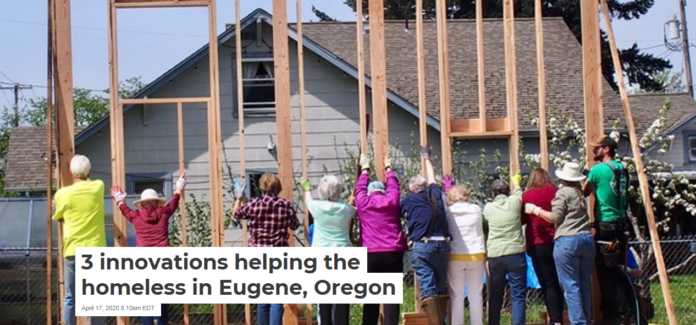

Mohamed Hassan Awad, California State University, Los Angeles
Even when the economy is booming, the United States has trouble figuring out how to deal with homelessness. Now, with unemployment soaring and millions of Americans unable to pay their rent, solutions are more needed than ever.
I think it’s worth considering some of the ways Eugene, Oregon – a city of about 170,000 people – has approached this problem. A citywide effort to count the homeless in December 2019 found 2,165 people who were either sleeping in shelters or on the streets. With 432 homeless persons for every 100,000 residents, Eugene has the highest number of homeless per capita in the country. The national average is only 170. Despite a recent uptick, the total number of the homeless in Eugene fell between 2011 and 2016.
When I studied the mid-sized city’s approaches, three programs struck me as particularly promising. All of them are a result of the local government working with nonprofits and concerned residents to solve this daunting problem.
A local housing movement
Efforts to do more about homelessness in Eugene took shape during the Occupy movement, which began in New York City in 2011 to protest inequality and soon spread across the globe.
In December 2011, an Occupy encampment, located at a park in the middle of the city, hosted hundreds of the homeless, championing homelessness as the movement’s main cause in the city.
The camp triggered a citywide public debate over how to solve this problem. That debate, in turn, led to close collaboration between the city and county governments, neighborhood associations, local nonprofits and activists and the city’s homeless community. Besides providing services for the homeless, several innovative programs came out of this collaboration.
1. Occupy Medical
Being homeless is fraught with medical and health problems, from sleep deprivation to a high risk of becoming injured. Eugene’s Occupy Medical, a clinic with both mobile services and a permanent location, is staffed by volunteer doctors, nurses, nutritionists and other health professionals – and also offers services like basic grooming.
The clinic requires no insurance or even an identity card. Anyone seeking medical help is welcome on a no-questions-asked basis. “It’s more than just a free clinic,” the clinic manager explained during an interview I conducted. “It’s the model that we have of judgment-free, patient-centered care, integrated health, community involvement and recapturing your own body.”
2. ‘Rest Stops’
Eugene bans sleeping in public places, which can lead the homeless to spend their nights in nearby forests and along river banks. Its “Rest Stop” program, a collaboration between the local city government and nonprofits, offers safe temporary shelter for people to transition to more permanent lodging.
Eugene’s authorities provide land in parcels big enough to host up to 20 individuals in Conestoga Huts, hard-shelled, insulated tents that were locally designed and built. The huts are mobile and can not be connected to electricity, gas or running water. Occupants are allowed to stay for up to 12 months. During their stay, occupants are expected to get mental health services, apply for jobs and seek out affordable housing. Nonprofits fund and operate these places at no cost to taxpayers. No alcohol or drugs are allowed on the premises.
3. Tiny house villages
Tiny houses, free-standing homes that may or may not include kitchens and bathrooms and are only up to 400 square feet in size, are growing more popular. Villages of these diminutive homes reserved for the homeless are springing up everywhere from Seattle to Austin to Detroit.
Eugene led the way in 2013 with its Opportunity Village, building on the lessons it learned through the Rest Stop program. The village offered permanent housing structures with access to shared kitchen, bathroom and laundry facilities for 30 individuals.
Emerald Village Eugene expanded to offer 22 permanent, fully equipped houses that range in size from 160 to 288 square feet. Volunteers designed and built the structures and residents are maintaining them and the surrounding land, enforcing their own village code and screening future occupants. Individuals and families began moving into this village in 2018. Their payments of between US$250 and $350 per month cover all their housing, utilities and maintenance costs. The rent residents pay goes toward their purchase of a stake in the land and their homes. A third village of tiny houses in the nearby community of Cottage Grove will accommodate another 13 tiny houses people, following a similar model.
[You’re smart and curious about the world. So are The Conversation’s authors and editors. You can read us daily by subscribing to our newsletter.]![]()
Mohamed Hassan Awad, Assistant Professor of Entrepreneurship, California State University, Los Angeles
This article is republished from The Conversation under a Creative Commons license. Read the original article.



















